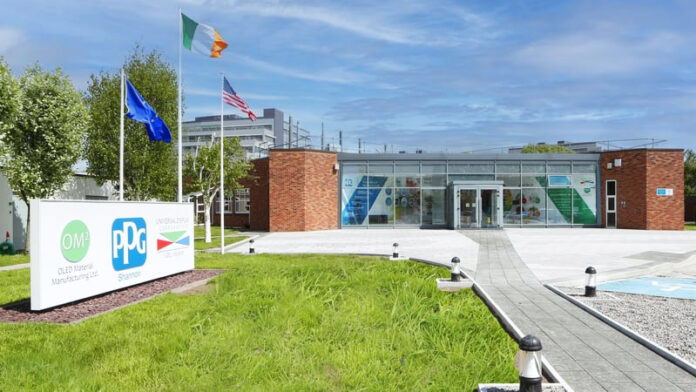
A RECENTLY opened manufacturing facility in Shannon is the first of it’s kind in the Mid West, and anywhere outside the US.
The joint collaboration between Universal Display Corporation (UDC) and PPG will produce OLED materials, which go into smartphones, TVs, laptops and smart watches.
The €10 million factory, opened on Thursday last (May 18) by Minister for Education Norma Foley, will provide a total of 100 jobs when fully operational. The facility currently has 50 staff.
Speaking to the Limerick Post, Gerry Cahill, plant manager of the UDC and PPG plant in Shannon, said that the products that will be produced in the plant bring vivid colour to new digital displays.
“What we do here is we make a powder at its most basic, that powder is put into a smartphone and the battery in your smartphone gives it a little bit of energy and when you put energy onto the OLED, it gives off light.”
“The highly intense colour that you see on your smartphone is what we make.”
Austin McCabe, general manager of UDC, told the Limerick Post that OLED technology has a wide range of uses.
“An example of where OLED displays are used would be in your smartphone, your smartwatches, your laptops, your tablets and TVs, so that’s where the OLED technology is used,” he explained.
The site in Shannon will be the first of its kind outside the United States and was specially chosen because of the skilled workforce in the Mid West region.
Mr McCabe said: “There’s only three sites in the entire world that make OLED displays. One in Monroeville, Pennsylvania, one in Barberton in Ohio, and now in Shannon, Ireland.”
“There’s a pharma-chem cluster in the greater Munster region, and in the Shannon region, so we can pull from that talent pool,” he said.
The site in Shannon underwent an initial €10 million investment, and will expand in years to come into a multi-million euro manufacturing campus.
The 50 current high-tech roles at the Shannon facility include engineering and operational disciplines, supply chain roles, synthetic chemists, and analytical technicians, and will expand to employ 100 people.
Mr Cahill said that the former pharmaceutical site that their facility is now based on was a major advantage to the company.
“The substances we make basically use the same technology as pharmaceuticals, so this was an old pharmaceutical site and, in effect, UDC came in and retrofitted some of the equipment and now it’s able to make OLEDs very efficiently,” he said.
Mr Cahill said that the team on the site was built “from scratch” and everyone is excited to see the plant start producing.
“They’ve seen the facility go from basically a dead plant to what is now a live plant producing OLEDs that we sell and supply to UDC, so it’s been a fantastic experience for everybody here,” he concluded.










